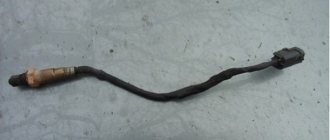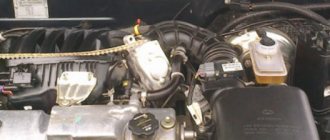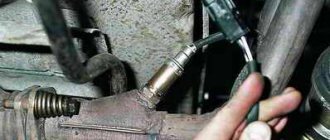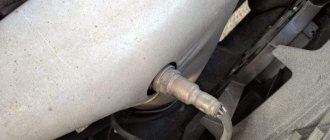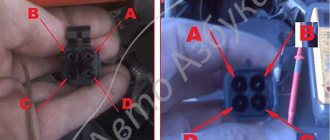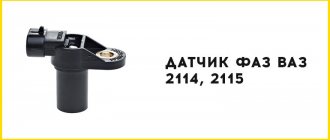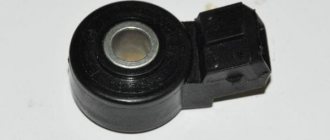Catalyst for VAZ 2115
Every owner of a "tag" at some point faces a problem with a catalyst. And then he needs an urgent replacement of the catalyst on the VAZ 2115. The old muffler often even sags so low that it clings to everything that lies incorrectly on the road surface. Of course, you can use fixing straps or wire, but this will not help. In any case, the VAZ 2115 catalyst needs to be replaced.
Where is the catalyst for the VAZ 2115
As I said earlier, you need to change the catalyst to a spider.
After you have changed the spider with two oxygen sensors, you must definitely flash the car from Euro-4 to Euro-2. Otherwise, the revs will jump and the car will consume gasoline. She doesn’t understand what mixture she should prepare according to the readings of the sensors. Either a poor mixture (but it starts to burn), or a rich one. In general, she went crazy with me from such an event)))
Since the diagnostics showed that the mass air flow sensor needs to be replaced, I replaced that too. The most expensive sensor on our basins, however. But there is nowhere to go. Moreover, I have a 116 sensor and it was not available in stores. I had to order it in the store) Well, before buying a mass air flow sensor, always check the latest numbers. It’s either 037 or 004 or, like mine, 116. The difference with 116, besides the numbers, is the green paint in the form of a circle on the body =)
Now the next step is to replace the injectors of cylinders 3 and 4. It will be tomorrow!)
Thank you all for your attention!) I hope the information will be useful for someone!) Don’t forget to leave a thumbs up! =) Good luck to everyone on the roads!)
Catalyst for VAZ 2115
Every owner of a "tag" at some point faces a problem with a catalyst. And then he needs an urgent replacement of the catalyst on the VAZ 2115. The old muffler often even sags so low that it clings to everything that lies incorrectly on the road surface. Of course, you can use fixing straps or wire, but this will not help. In any case, the VAZ 2115 catalyst needs to be replaced.
Insert instead of catalyst VAZ 2114 8 valves
- To the beginning of the forum
- Forum Rules
- Old design
- FAQ
- Search
- Users
If the cat is working and you don’t plan to install anything other than a spider (a direct-flow resonator, a muffler) - then there are only disadvantages: flashing, you won’t pass MOT, at the post when measuring CO-CH they will take off the numbers
On the plus side, there may be an increase of 2-3 mares
Has anyone installed electronic decoys for a second oxygen sensor?
You put 4-2-1 Stinger without any Subaru sound
If I’m not mistaken, then “4-2-1” is structurally longer than “4-1”, and therefore will not fit with the original resonator
Added after 7 minutes 33 seconds:
Friends, thank you for your answer. I replaced my burnt-out catalyst with a regular no-name Spider “4-1” (1100 RUR.
), because I couldn’t find a stinger in the city, so I didn’t bother with delivery. I left the second sensor, screwing it into a mechanical snag. At the same time, I changed the receiver gaskets, cleaned the throttle body, and filled in new antifreeze, of course. I checked everything 10 times, on the first day I drove 6 kilometers around the city in different modes - quiet and fresh air in the cabin, even in my opinion the ride became better
Added after 9 minutes 26 seconds:
But the next day, after driving 10-15 km along the highway, a problem was revealed - it jerks in 3rd and higher gears, especially when “pulled” (uphill, at rpms less than 2000, etc.). At idle everything is fine - it holds the speed, you accelerate and it doesn’t stall. At first the fault was that the second oxygen sensor was not disconnected, but after disconnecting the connector nothing changes, moreover, the check does not light up. Looks like he's already switched off in his brain?
Friends, tell me what to do: 1) Measure the compression, check the quality of the gasket installation on the block? 2) Check the connection between the receiver and the inlet? 3) Or is there nothing to do with the mechanics and take the ELM327 into your hands and see what your brains see?
good coming from the very bottom.
and nothing bothered me. euro2 bosch.
Added after 5 minutes 58 seconds:
or find a Bosch 7.9.7 brain and sell yours.
Bosch is smoother. adapts better to imperfect hardware
Well, it wouldn’t hurt to measure the compression, of course.
Should the check light be on on the “factory” firmware if the second oxygen sensor is physically disconnected from the connector?
Probably some kind of “tune” has already been filled in of unknown quality and origin
Probably some kind of “tune” has already been filled in of unknown quality and origin
Damn, I thought so, judging by the way she reacts to the gas pedal. The last nine didn't have this. Thank you very much for your help. I won’t be able to flash it myself in the coming days. As soon as I manage to localize the problem, I’ll write back, maybe my experience will be useful to someone.
Added after 4 minutes 50 seconds:
Only, if the second oxygen sensor is already turned off, it turns out that the brain should not “see” that the catalyst is no longer there, which means it should drive the same way as before replacing the exhaust. And she began to twitch.
What can a damaged catalyst cause?
If the catalytic converter is only clogged with soot, it can still be cleaned. But if you do not pay attention to the problem that has arisen, then in the best case, the car simply will not be able to start one day, or the engine will start, but quickly stall.
It’s worse if the reel melts due to soot. It will not be possible to restore the damaged element, then either replacing the catalytic converter or removing it and installing a flame arrester will help restore engine performance.
The worst option is mechanical destruction. Honeycomb particles can significantly impede the passage of exhaust gases through the catalyst.
Because of this, some of the gases can return back to the cylinders, and even with ceramic impurities.
And foreign objects in the cylinders, even small ones, can lead to damage to the cylinder-piston group and the need for major repairs.
But you shouldn’t always “sin” on the catalyst; it can only be a consequence of the fact that one of the car systems is not working correctly, or low-quality fuel with a large number of additives is poured into the car.
Therefore, even with the slightest drop in power, you should immediately diagnose the state of the power and ignition systems, as well as evaluate the performance of all sensors, and only then check the catalyst.
How does a catalyst differ from a flame arrester?
The task of the flame arrester is to reduce the exhaust volume and burn out excess fuel that is not burned in the cylinder, so it cannot reduce toxicity. If you install it instead of a catalytic converter, then not only will the exhaust toxicity increase, but the engine will also not work properly, because the ECU will reduce the fuel supply so that the amount of oxygen at the output of the device approaches the norm.
When the catalyst on a VAZ 2114 car is removed to install a flame arrester, you have to either use “decoys” that simulate the operation of lambda probes, or change the firmware of the control unit so that it does not take into account the readings of these sensors.
Solution
In fact, the cleaning element itself cannot be repaired. Only replacement is possible. And this is where the fun begins. Many car owners simply refuse to replace a faulty converter with a new one. The main reason for this is the high price. Sometimes it exceeds the residual value of the car. The quality of the fuel also plays an important role.
Most car enthusiasts use a simple and inexpensive replacement method - install a flame arrester instead of a catalyst. This device almost completely replaces the neutralizer. The only drawback is that there will be slightly more harmful impurities in the exhaust. But within the limits of the norms accepted in Russia. Moreover, the installation of a flame arrester is officially permitted by the relevant authorities.
There is another option for replacing the catalyst - installing an insert, or “spider”. This is also an approved replacement device. Like flame arresters, it is produced by industrial factories. It has several varieties for different engines. The main difference is in the product configuration.
Popular myths
Varieties
Some people deliberately get rid of the catalyst, others deliberately ignore the clogged unit. All this caused the spread of myths.
- By removing it, the engine gains power. A misconception that arose for unknown reasons.
- The engine cannot “breathe” normally due to the catalyst. Absurd. It functions quite well if the cat itself is in working order.
- A clogged element ensures a more environmentally friendly ride. Another myth, the origin of which can only be guessed at. Rather, on the contrary, a clogged device harms nature and your car even more.
Therefore, monitor the condition of the catalyst on the VAZ 2114, check its functional condition, and if necessary, replace it with a new one or replace it with a flame arrester. Both options have shown their effectiveness.
In the context of the fight for the environment, car manufacturers are coming up with more and more sophisticated ways to reduce harmful emissions into the atmosphere, thereby preventing the engine from developing its full power.
The catalyst plays an important role in trapping harmful substances.
Installed in the exhaust system, it captures harmful substances from the exhaust, turning them into less harmful ones, acting as a kind of filter.
However, it is known that over time, every filter becomes clogged. With high mileage, the catalyst can cause deterioration in the vehicle's driving characteristics and increased fuel consumption. In addition, over time, the filter element, honeycomb, begins to crumble due to low-quality gasoline, thereby preventing the car from driving normally.
Since a new catalyst is expensive, many car enthusiasts resort to such a thing as removing the catalyst. Usually it is simply cut out or a so-called insert is installed instead.
Why do you need a catalyst?
Usually, when it comes to a catalyst, most motorists only think of a muffler, or rather a can or pipe. In fact, the exhaust system of a car includes several elements: connecting pipes, muffler, resonator, corrugation, catalyst, etc. So:
- The catalytic converter, as the catalyst is called, is a fairly important element of the car and the entire exhaust system.
- One of the main functions assigned to it is the purification of exhaust gases that flow through the pipe. The latest Euro 2 standards require the presence of a catalyst in the exhaust system of the car and a special oxygen sensor.
- The neutralizer itself, despite the fact that it is made of metal and a massive body, is a rather fragile element. He is afraid of severe mechanical damage, and is also quite sensitive to low-quality fuel. Impurities and various dirt residues contained in low-quality gasoline remain on the walls of the catalyst, gradually accumulate there and lead to damage to the part. In Russian conditions, the catalyst fails very quickly. And if, usually, it is designed for 200,000 km of run, then if it comes into daily contact with Russian fuel, it will not withstand even 30,000 km of run.
It is useful to know what a catalytic converter is made of. And find out how this part works. As was said, it reduces the amount of harmful substances and impurities that any car with an internal combustion engine emits into the surrounding atmosphere. These are substances dangerous to human health, such as carbon monoxide, nitrogen oxide, etc. For example, carbon monoxide is a real gas that has neither color nor odor. But it is precisely this that contributes to the appearance of cardiac colic and headaches in people. As for the design of the catalyst, it consists of a ceramic or often metal honeycomb part. Why honeycombs? Yes, because the design resembles a honeycomb. On top of these same honeycombs, special precious metals, most often platinum, are sprayed. Although palladium catalysts are often used in the automotive industry of developed countries.
Malfunctions
Here are the catalytic converter faults:
- the holes are clogged;
- the filter elements have come off the housing;
- the body burned out.
The main sign that the holes are clogged is a decrease in the power of the power unit, because the engine has to spend much more energy pushing exhaust gases through the converter.
The vehicle has trouble picking up speed, has difficulty going uphill, and sometimes won't start. In such situations, car owners often ask the question whether a catalyst is needed in the exhaust system of a VAZ 2114 or other models, since they negatively affect the behavior of the vehicle. They forget that the catalytic converter only lasts for a certain time, after which it needs to be replaced.
The main sign that the filter elements have become detached from the body is an increasing noise level, to which are added barely audible rattling sounds. This malfunction slightly reduces the efficiency of the device, because part of the exhaust gases bypasses the ceramic filling, in addition, the risk of burning out the housing increases sharply.
Signs of housing burnout are:
- sharply increased engine volume;
- unpleasant smell in the cabin;
- increased exhaust toxicity.
Almost always, a burnout of the body occurs after the appearance of both previous faults, so it is impossible to fully restore the part, and a patch applied to the burnout site will only reduce the noise level and unpleasant odor in the cabin.
How to check
If you suspect that the catalytic converter is faulty, then do the following:
- remove it from the car (to do this, on eight-valve cars you will have to remove the exhaust manifold);
- look at the gap, if you cannot see the light due to the shape of the device, then in a dark room place a bright flashlight at the outlet so that the light goes only into the device; if the reflection of light from the walls of the collector is dim, the catalyst is clogged;
- shake it and listen to see if the ceramic inserts rattle; if they rattle, then they have come off the body;
- turn the part over with its back side facing you and inspect the surface of the ceramic filler, if it is intact, everything is fine, but if it is cracked or collapsed, the neutralizer needs to be changed;
- inspect the body for burns and dark spots; if there are any, the device needs to be replaced.
Remember, this element cannot be fully repaired, so trying to repair a faulty part will not return it to the ability to effectively burn exhaust gases.
Catalyst malfunctions
There is another rather controversial way to check this part for clogged channels by checking the pressure in the exhaust system, because the catalyst in a VAZ 2114 car is located in the path of exhaust gases. To use it, do the following:
- Start the engine and listen to it idle, then turn it off.
- With the engine off, unscrew the spark plug of any cylinder and place it so that the threads touch grounded metal.
- Disconnect the injector on that cylinder, then start the engine and listen to how it runs. If the speed drops slightly and the engine begins to vibrate, then everything is fine with the catalyst. If the engine, despite the tripping, begins to work better, it means the catalyst is clogged.
But this method is controversial, so its results should not be used to make any decisions on the future fate of the catalytic converter.
There is another reliable, but difficult to implement method of checking: before the engine warms up, unscrew the first oxygen sensor (this is not easy to do, because it almost always sticks strongly to the thread), then screw a compression gauge or pressure gauge into the hole. Having done this, start the engine and warm up the engine, then ask an assistant to gently press the gas so that its speed varies within 2-5 thousand rpm. If the pressure does not rise above 0.5 atm, then the catalyst is not clogged, but if it is higher, the part needs to be replaced.
Repair and replacement
As we said above, a full repair of this part is impossible, so if environmental friendliness is important to you, then in case of any defect, the catalytic converter must be replaced. However, the majority of drivers, who do not understand why a catalyst is needed in a VAZ 2114 or any other car, and also consider its main function (afterburning exhaust gases) to be unimportant, prefer to repair it or install some kind of replacement.
Here are the most popular repair methods:
- knocking out ceramic filler;
- filling the void with metal mesh;
- welding patches onto burnout areas.
All these methods involve opening the housing of the removed part, because the catalyst in the VAZ 2110 is located in a place where it is impossible to perform any repairs on it.
To repair the neutralizer, do the following:
- Using a grinder (angle grinder, angle grinder), cut 2 lines running across the body near the front and rear edges;
- cut 2 lines along the body to cut out a rectangle;
- pull out the ceramic filling through it, if necessary, break it first;
- fill the void inside the case with steel wool or any other similar steel material; insert the cut plate into the hole and weld it.
Remember that it is advisable to cook stainless steel in an argon or carbon dioxide environment.
What can be used instead of a catalyst?
If you do not want to repair the neutralizer, then instead of it you can install:
- catalyst of a different type or size;
- various flame arresters or resonators;
- stainless steel pipe.
Even on cars of the Euro-4 class, it is technically possible to install a neutralizer for Euro-2, but for this you will have to change the ECU firmware, because the control unit will no longer receive information from the second oxygen sensor. You can also install catalysts that were originally intended for other cars with the same or larger power units, and if the unit fits the class (Euro-2 or Euro-4), then you don’t even have to change the firmware.
Flame arrestors and resonators perform the same function, but the former are better able to withstand high temperatures, so they will last longer in place of the catalyst. A stainless steel pipe will cost much less, but will last several times less, because due to the lack of a heat-insulating layer, it is more susceptible to corrosion.
In any case, such a replacement implies serious intervention in the exhaust system, because the catalyst in the VAZ 2112 is located in the path of the exhaust gases. Therefore, whatever you install in its place, the replacement part must be made of a material that can withstand high temperatures and resist corrosion.
Remember, the choice of replacement part depends on where the catalyst is located in the VAZ 2114 car; if behind the engine, then a new neutralizer or flame arrester will do, but if under the bottom, then you can install anything.
Flashing the ECU
Inexperienced car enthusiasts who do not understand how the injector works ask the question: do you need to flash the car after removing the VAZ 2114 catalyst, or can you do without it? To answer this question, it is necessary to consider the operation of the control unit of the injection power unit.
Sensors, including one or both lambda probes, supply the ECU with information about engine operation and driver commands, then the control unit analyzes them in accordance with the program (firmware) loaded into it and sends signals to various actuators.
What is a catalyst in a car?
Removing the catalyst deprives the ECU of information from one or two sensors, which it perceives as a malfunction and proceeds with a program built into it, that is, it adjusts the amount of fuel. This leads to a sharp increase in exhaust toxicity and fuel consumption. To some extent, various deceptions that imitate the operation of lambda probes help correct the situation, but they cannot greatly reduce toxicity and fuel consumption, but they convince the ECU that everything is working normally.
Replacement on a 16-valve engine
In the case of a 16-valve power unit, the catalyst is included in the design with the output manifold. Therefore, look for it behind the cylinder block directly in the engine compartment.
The nuance of dismantling the 16-valve engine is the presence of two lambdas.
- The first is located directly on the catalyst. It serves to adjust the fuel mixture;
- The second is located on the flange after the device. It is called ecological. If this lambda is not in place, the sensor will immediately generate an error, the injection will stop working properly, thrust will increase and fuel consumption will increase.
There are two ways to solve this issue:
- If you bought a spider for one regulator, the electronic control unit can be upgraded to Euro 2 from the current Euro 3. But such a spider has a serious drawback - the only thread for the lambda is on the flange. To mount the injection lambda there, you will have to assemble an extension cord from a wire and two connectors, called mother-father.
- If it is a spider with two regulators, the injection lambda is mounted in a standard socket. The thread for the second sensor is plugged or a dummy for the electronic control unit is installed in its place. In the second situation, there is no need to reflash the ECU.
Why do you need a catalyst?
Usually, when it comes to a catalyst, most motorists only think of a muffler, or rather a can or pipe. In fact, the exhaust system of a car includes several elements: connecting pipes, muffler, resonator, corrugation, catalyst, etc. So:
- The catalytic converter, as the catalyst is called, is a fairly important element of the car and the entire exhaust system.
- One of the main functions assigned to it is the purification of exhaust gases that flow through the pipe. The latest Euro 2 standards require the presence of a catalyst in the exhaust system of the car and a special oxygen sensor.
- The neutralizer itself, despite the fact that it is made of metal and a massive body, is a rather fragile element. He is afraid of severe mechanical damage, and is also quite sensitive to low-quality fuel. Impurities and various dirt residues contained in low-quality gasoline remain on the walls of the catalyst, gradually accumulate there and lead to damage to the part. In Russian conditions, the catalyst fails very quickly. And if, usually, it is designed for 200,000 km of run, then if it comes into daily contact with Russian fuel, it will not withstand even 30,000 km of run.
Repair and replacement of the neutralizer
Replacing the catalyst in a VAZ 2115 is carried out only after analyzing the peculiar sounds emitted by the exhaust system. It may also be an unusual smell or color of the exhaust gas. Common symptoms of a faulty catalytic converter include a rattling sound, like scraping metal, coming from underneath the car. In such cases, it is urgently necessary to replace it with a new catalytic converter or a homemade flame arrester, which copes well with the basic functions of the factory catalyst.
The right tool
For work we will need a set of tools:
Attention: The inspection hole is a mandatory element of the work process, onto which the car should be raised. Although in some cases drivers use a regular lift.
Removing the catalyst
- lift the car onto a pit or jack;
- unscrew the bolts securing the converter to the exhaust pipe;
- remove the bolts together with the springs, using a 13mm wrench;
- take a screwdriver with a wide blade and pry off the graphite-containing O-ring;
- remove it;
- proceed to unscrewing the rear mounting bolts (there are also two of them);
- to unscrew, use a 17mm wrench;
- when unscrewing and removing the nuts, hold the bolt from turning with another 17 wrench;
- remove the neutralizer.
Replacement on a 16-valve engine
In the case of a 16-valve power unit, the catalyst is included in the design with the output manifold. Therefore, look for it behind the cylinder block directly in the engine compartment.
The nuance of dismantling the 16-valve engine is the presence of two lambdas.
- The first is located directly on the catalyst. It serves to adjust the fuel mixture;
- The second is located on the flange after the device. It is called ecological. If this lambda is not in place, the sensor will immediately generate an error, the injection will stop working properly, thrust will increase and fuel consumption will increase.
There are two ways to solve this issue:
- If you bought a spider for one regulator, the electronic control unit can be upgraded to Euro 2 from the current Euro 3. But such a spider has a serious drawback - the only thread for the lambda is on the flange. To mount the injection lambda there, you will have to assemble an extension cord from a wire and two connectors, called mother-father.
- If it is a spider with two regulators, the injection lambda is mounted in a standard socket. The thread for the second sensor is plugged or a dummy for the electronic control unit is installed in its place. In the second situation, there is no need to reflash the ECU.
Replacing a device on a 16-valve engine
Catalyst for a 16-valve engine
In this case, the catalyst is located together with the exhaust manifold, and you should look for it under the hood of the car, in the immediate vicinity of the cylinder block. To replace the unit, we need a catalyst with zero resistance, or – as it is popularly called – a “spider”. It is quite possible to replace the device in your own garage. The first nuance when replacing a unit is dismantling the fuel rail. The second is the presence of two lambda probes. The first is located directly on the catalyst and is responsible for setting up the fuel system. The second one is located after it, on the flange. Very often it is called “ecological”. If the lambda malfunctions, the sensor generates an error and fuel injection begins to work incorrectly, resulting in an increase in traction and, accordingly, fuel consumption. There are also two ways to solve this problem. The first is to purchase a “spider” with one regulator and flash the electronics unit from Euro-3 to Euro-2. But there is one BUT, there is only one thread on such a spider, and it is on the flange. This means that to install the device you will have to assemble an extension cord consisting of wires and two connectors, popularly called “male and female”. The second is to purchase a “spider” with two regulators and simply install it in its regular place. In this case, there is no need to reconfigure the electronics.
Product delivery options
Note! Below are the shipping methods available specifically for this product. Payment options may vary depending on the shipping method. Detailed information can be found on the “Delivery and Payment” page.
Parcel by Russian Post
Available payment methods:
- Cash on delivery (payment upon receipt)
- Using cards Sberbank, VTB, Post Bank, Tinkoff
- Yandex money
- QIWI
- ROBOKASSA
Shipping throughout Russia. Delivery time is from 5 to 12 days.
Parcel by Russian Post 1st class
Available payment methods:
- Cash on delivery (payment upon receipt)
- Using cards Sberbank, VTB, Post Bank, Tinkoff
- Yandex money
- QIWI
- ROBOKASSA
Shipping throughout Russia. Delivery time is from 2 to 5 days. More expensive than regular delivery by Russian Post, approximately 50%. Parcel weight up to 2.5 kg
Express Parcel EMS
Available payment methods:
- Cash on delivery (payment upon receipt)
- Using cards Sberbank, VTB, Post Bank, Tinkoff
- Yandex money
- QIWI
- ROBOKASSA
Shipping throughout Russia. Delivery time is from 3 to 7 days. More expensive than regular delivery by Russian Post, approximately 100%.
Transport companies
Available payment methods:
- Using cards Sberbank, VTB, Post Bank, Tinkoff
- Yandex money
- QIWI
- ROBOKASSA
Delivery is possible to any locality where there is a representative office of the transport company. Delivery time is from 2 to 10 days. Sending large parcels is approximately 50% more profitable than by Russian Post.
Pickup from our warehouse
Available payment methods:
- Cash upon receipt
- Credit, installments
- Using cards Sberbank, VTB, Post Bank, Tinkoff
- Yandex money
- QIWI
- ROBOKASSA
Pickup times must coincide with store opening hours.
Vehicles of the VAZ (Lada) auto concern represent a set of complex devices that interact to perform a certain set of functions, the calculation of which is carried out by the best engineering forces of the design bureau. The coordinated operation of the relevant elements of the VAZ 2110 ensures uninterrupted operation of the vehicle. The coordinated actions of the electronic control module and the exhaust gas removal system create a balance in the functioning of the VAZ 1117 components.
The electronic control module of the VAZ 2190 ensures the correct supply of air and fuel based on the readings of signals from oxygen sensors installed in the exhaust system. When the O2 sensor reads data with lean readings, the module enriches the fuel mixture, and, conversely, when processing readings with a rich mixture, the module reduces the turn-on time of the fuel injectors, leaning the fuel mixture. Quickly changing the air and fuel mixture to average levels allows you to control emissions, keeping them at a minimum level.
During operation, the internal combustion power unit of the VAZ 2192 produces “exhaust gas noise” due to the alternate firing of the cylinders and the resulting pulsating exhaust gases from the outlet openings of the cylinder head. To muffle noise and reduce the sound energy of the exhaust gas flow, technical engineers use two techniques: absorption and reflection of sound in a muffling device called a muffler. Sound absorption and change in sound wavelength occurs after the exhaust chambers with exhaust valves. Thanks to the attached exhaust manifold and catalytic converter with O2 sensors mounted on it, particularly unwanted frequencies are eliminated from the exhaust of a VAZ 2170 car. Catalytic converters also have a sound-absorbing effect.
The VAZ 2114 vehicle itself is subject to strong vibration when driving, producing noise through its own frequencies transmitted to the car body. Therefore, careful coordination of the entire system is required here, including the stage of design and positioning of individual elements and their fastenings, based on technical calculations and driving characteristics of the VAZ 2112. Accurate data ensures the creation of a perfect power unit that fully interacts with the exhaust system, taking into account the identified shortcomings when identifying the needs of motorists.
The standard exhaust manifold has a one-piece, cast-iron design, which is responsible for the product's endurance at high internal exhaust gas temperatures. Mass production does not allow the auto manufacturer to treat the cast iron to soften the rough inner surface, which slows down the flow and creates a backflow for gases to escape.
A catalytic converter with O2 sensors monitors the level of emissions of harmful substances from the VAZ 2119, cleaning the exhaust from atmospheric pollutants. The use of low-quality fuel clogs the pores of the converter, making it difficult for gases to pass through and creating congestion, which reduces the supply of fresh air and fuel components, leading to engine shutdown.
In order not to violate strict environmental rules, but also to avoid interruptions in the operation of the VAZ 2191 power unit, you should replace the faulty standard catalyst and manifold, using an insert with the ability to install factory O2 sensors until the time of purchasing a new catalyst. The replacement cat collector is similar in size to the standard parts; installation is carried out by the car enthusiast in the standard places.
Removing the catalyst on Niva 21214: consequences
Once removed, you will notice a significant increase in power. But let us immediately note that it will be within the factory values. After all, before this, the engine simply suffocated on its own gases and the power could drop by almost half. Gases will freely leave the combustion chamber - the risk of valve burnout is minimal.
Fuel consumption after removing the catalyst is within the factory values. But malfunctions will occur very rarely. After all, “when cold” the ECU is guided by average lambda values. And so on until the catalyst warms up. After removing it and flashing it, the unit will think that the neutralizer is already warmed up and will immediately begin to prepare the correct mixture.
The car will become less demanding on the quality of the fuel used. Even if there are deposits, all the dirt will fly straight into the pipe without being trapped in the filter honeycombs.
As for the negative aspects, after such “tuning” your environmental standards will immediately drop to Euro-2. But in Russia there are no penalties for this. It is completely legal to drive a Chevrolet Niva without a catalyst.
Signs of a faulty catalyst on a VAZ-2115
- On the center console of the instruments, a yellow indicator with the inscription “Check” flickers, indicating a breakdown in the engine.
- Fuel consumption is above the permissible limit. This symptom is also characteristic of other breakdowns, so you should be extremely careful when identifying it. For objectivity, it is better to use two or three signs.
- Engine power systematically drops, this is especially noticeable during long climbs.
- Vibration is heard in the front axle area.
- A strange sound appeared in the engine compartment. This feature is characteristic of catalysts with a ceramic base. When it crumbles inside, a ringing sound is heard in the exhaust manifold.
- The smell of exhaust gases inside the cabin.
Breakdowns and their signs
Typically, this element begins to “strange” when it travels about 150 thousand kilometers. That is, this is more likely an age-related problem with the car.
Standard and Modified
Typical signs that the catalyst is clogged are:
- The car's dynamics deteriorate significantly and noticeably;
- The engine starts with problems;
- There is a characteristic smell of sulfur in the cabin;
- The engine is unstable at idle.
